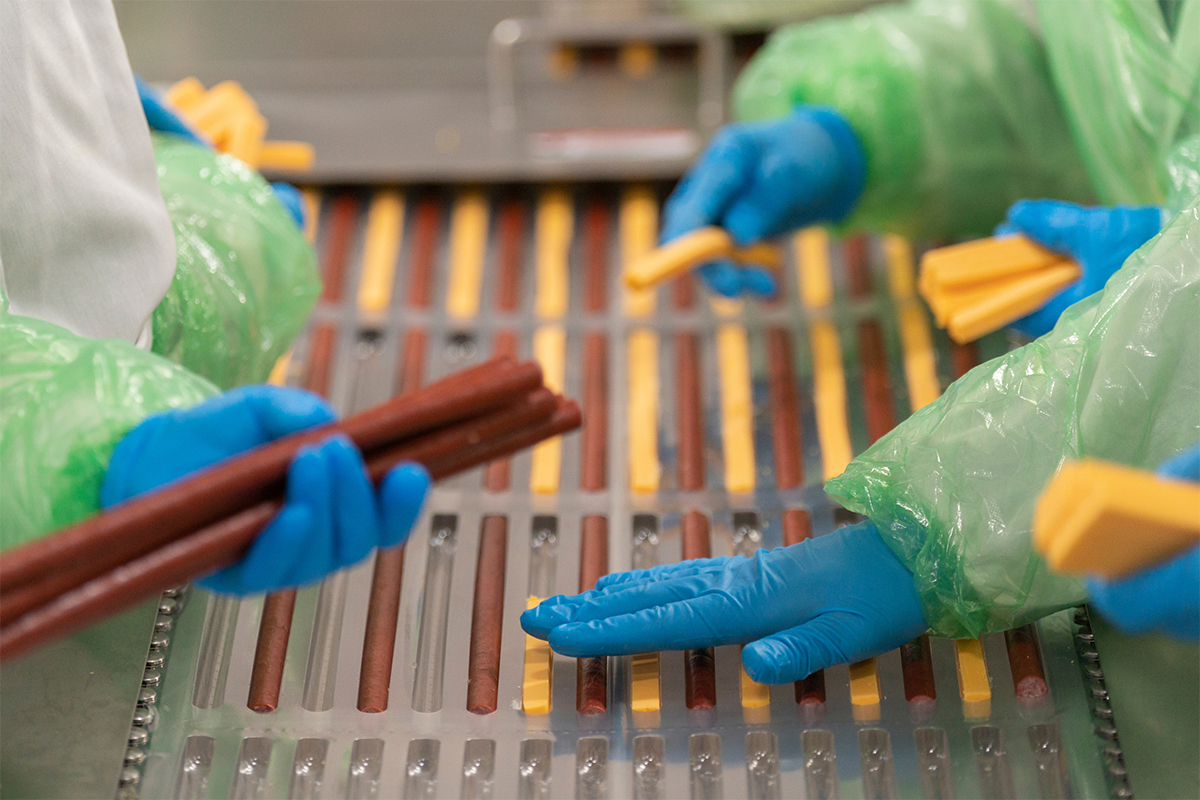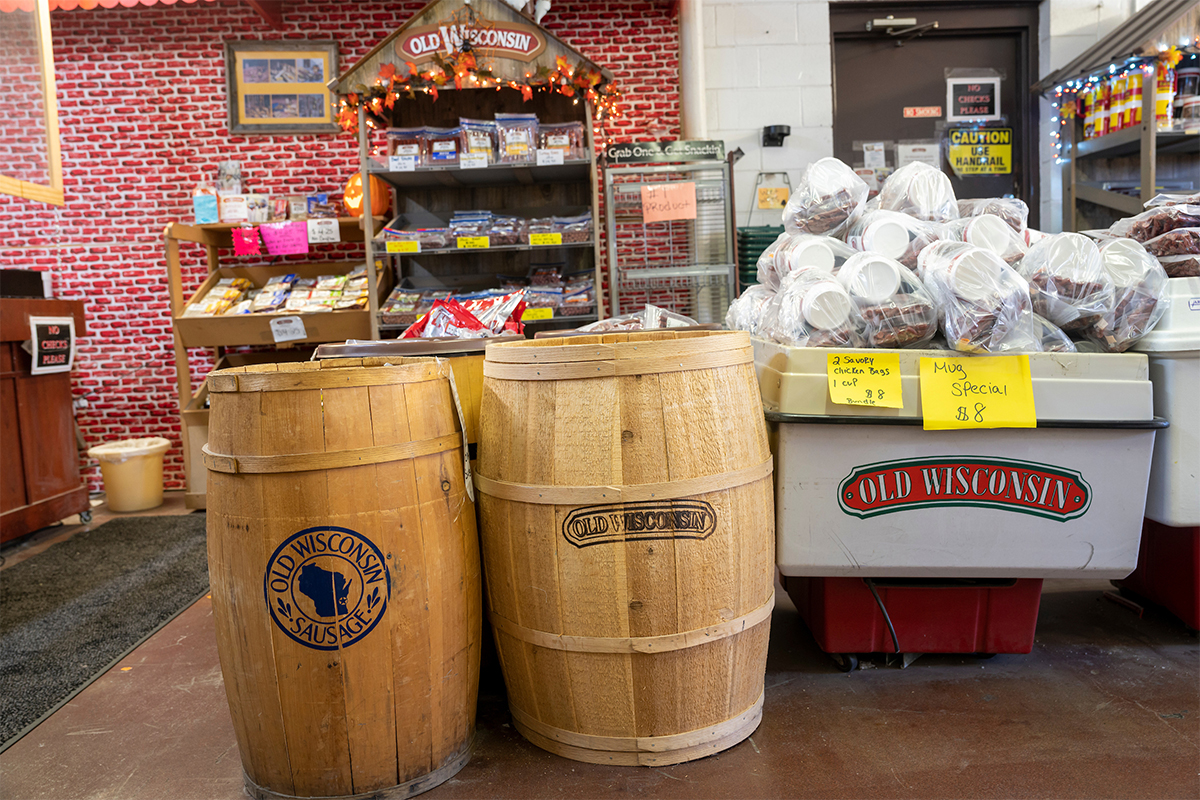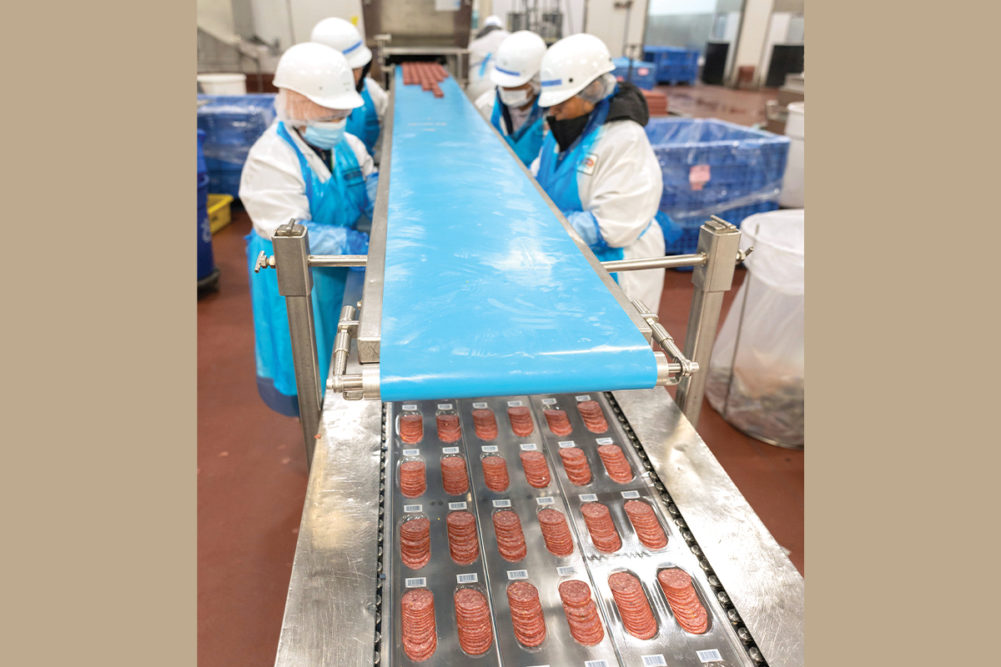Old Wisconsin Sausage Inc., Sheboygan, Wis., celebrated its 75th anniversary this year. The company started as a small butcher shop in Elkhart Lake in 1947. The partners in that butcher shop split and one of them moved to Sheboygan and opened Thielmann’s Sausage Co., which became Thielmann’s Old Wisconsin. In 1981 Carl Buddig and Co. acquired Thielmann’s Old Wisconsin and dropped the “Thielmann’s” part of the name.
Today, Old Wisconsin relies on the same attributes as it did from its beginning to now, family business values that focus on people, and a strong community with a strong work ethic.
“There’s a talent in this community and county that built that quality and the quality around family businesses,” said Bob Buddig, chief executive officer of Carl Buddig and Co.
“We’re very proud of our community,” added Steve Harrison, vice president and general manager at Old Wisconsin. “We’re proud of the people that work here. We’ve got a lot of amenities that make us special, I think, including in our business and the people that we take care of as a result of employing 500 people here at Old Wisconsin.”
Change and growth
Today, Old Wisconsin produces over 40 million lbs of sausage and meat snacks a year. The company sells more products in one month than it did in an entire year 40 years ago. And in the last decade it’s doubled its production, doubled its staff (now about 500) and doubled its manufacturing footprint.
Excluding a plant in Illinois that is related to some of the sausage production for Old Wisconsin, the Sheboygan packaging facility covers over 100,000 square feet and the formulation, stuffing, thermal processing and cut-down plant is 83,000 square feet. This provided Old Wisconsin with the means to increase its sales in the US convenience market 235%, while growing 312% across US mass club and drug retail markets, and bolster e-commerce sales by 66% in the past year.
The difficult decision to focus on shelf-stable meat snacks and summer sausage, and discontinue regionally distributed polish sausage, wieners, brats, etc., also contributed to the growth by widening distribution channels beyond retail grocery.
“That was a real complicated decision because those were legacy items and things we did very well, but they were regionally distributed,” Harrison said. “We had a lot of companies across the country that were screaming that they needed more of our snacking items. So, we made the decision to consolidate and eliminate those items.”
But expansion and strategy are not the only things that have changed or initiated growth at Old Wisconsin. Hand in hand with a focus on people and culture, Old Wisconsin takes great pride in taking care of its employees and doing it with actions rather than just words.
With the labor shortage in meat processing and the demand for their products high, Old Wisconsin committed to maintaining a generous work-life balance for workers. The nature of the industry dictates some weekend work and for years, employees had to work overtime to keep up with year-round demand, but recently a policy of flexibility has been implemented by the management team.
“The Saturdays and Sundays are fewer and fewer than we have had in past,” Buddig said. “And when we do have that, we want to try to be as transparent as possible. One of the comments was, ‘I don’t mind working on a Saturday, but let me know when.’ That’s the kind of thing we have to take into consideration and we’re doing that more and more.”
Overtime now is based on a schedule. Employees know when they have to work on Saturdays and can plan accordingly, and they know that two weekends per month they won’t have to work. For those that like the overtime, there’s a signup sheet for shifts outside of their department.
“That was huge in terms of building equity with our employees,” Chuck Pfrang, vice president of plant operations at Old Wisconsin, added. “To be able to go to them and say on these weekends you’re not working, and we mean it. I would say of all the things that we’ve done to build equity with our staff, that was huge.”
 By changing its focus to shelf-stable snack products and summer sausage, Old Wisconsin widened its distribution beyond grocery retail. (Source: Andy Manis Photography)
By changing its focus to shelf-stable snack products and summer sausage, Old Wisconsin widened its distribution beyond grocery retail. (Source: Andy Manis Photography)
Some things old…
Old Wisconsin built the 100,000-square-foot packaging plant in 2015 and moved into the greenfield build in 2016. Prior to the build, packaging had been at the formulation, stuffing, thermal processing and cut down plant, which gained about 35% floor space once packaging moved. The original plant also got a full make over with upgrades to match the new packaging plant.
“It was completely gutted and re-built under USDA inspection,” Pfrang said. “We were still making product the whole time.”
The new packaging plant handles approximately 130,000 lbs a day and 35 different formulations tracked from batch to combo to barrel. Depending on the product, some go directly to the packaging line, but either way, every single stick can be traced back to its origin at any point in the process.
Performance is tracked by real time metrics on large digital display monitors with finished product inventory stored in a warehouse with the capacity of 2,000 pallets. But the show piece of the new facility is an enclosed loft above that holds all the vacuum pumps for all the machines. It was a challenge for the builder, but Old Wisconsin, the engineers and builder worked through it and made it happen.
“That was something the employees talked about and suggested when asked,” Pfrang said. “They wanted us to get the vacuum pumps and the heat and everything else that comes with them off the floor, so that’s what we did.”
The 110,000 to 120,000 lbs per day produced at the formulation, stuffing, thermal processing and cut down plant starts with protein going through a coarse grind with 3/8-inch plate. From there, spices, culture and cure are mixed, and then it goes to the fine grind.
The emulsion is then dumped into Handtmann stuffers on the stuffing lines, which use cameras to look for foreign materials.
“We’ve got a perfect record,” Pfrang said.
Once stuffed, product is racked and sent first to a secret process that gives it a flavor unique to Old Wisconsin and then to one of 13 Alkar ovens to remove the precise amount of moisture, making them the highest quality meat snacks the company can produce.
“It’s traditional recipes that date back to the inception of the company, a German-style product that we still maintain,” Harrison said. “The other part is people really care about what they’re doing. The care that our staff puts in, they will take care of the detail, make sure the product is consistent and be proud of the product when it goes out the door.”
 Old Wisconsin's focus on shelf-stable meat snacks has worked well with the latest keto and protein snack trends. (Source: Andy Manis Photography)
Old Wisconsin's focus on shelf-stable meat snacks has worked well with the latest keto and protein snack trends. (Source: Andy Manis Photography)
People and culture
Buddig, Harrison and Pfrang all emphasize the focus on putting the right people in the right positions while letting those people find their way within the company and not locking them into a specific role. At a deeper level, it’s also imperative to make sure employees understand the philosophies and values of Old Wisconsin, and that includes executives and stakeholders.
Buddig uses the word transparency when describing the relationship between owners, executives, managers, employees, and the whole chain from Buddig family members to the workers on the floor. The trust built through transparency permeates every relationship, at every level. For Carl Buddig and Co. and Old Wisconsin, that’s what it means to be a family business.
“It’s important for our staff to understand that they’re important and you always have to find ways to thank them, compliment them for what they’re doing,” Harrison said. “The biggest component of that is being able to sit in a meeting, listen to what we’ve done, what we’re going to do, and be able to walk up to the CEO of the company, and either have suggestions, ideas, concerns or complaints.”
Old Wisconsin’s family ownership and community-driven dynamic result in a unique working environment. The people who work there understand their importance when the company involves them in planning and shares important information. The workforce also has access that many companies don’t offer through an open-door policy that extends all the way to the executive suite.
“I would say that Bobby [Bob Buddig] would take a phone call from anybody off the shop floor if they had a concern,” Harrison said. “What that’s done over the years is develop that same concept of family, of culture and of trust. We’re a community.”
Old Wisconsin also operates without silos. If employees show an aptitude or desire for food safety or worker safety, they will become a part of those teams and take on those tasks and responsibilities.
“This is a team sport, and we’re family, we all work together towards a common goal,” Pfrang said. “You are not bound by your job description in any way, shape or form, and if you look at our promotions, I don’t know the exact number, but I would guess about 90% of our promotions are all internal.”



